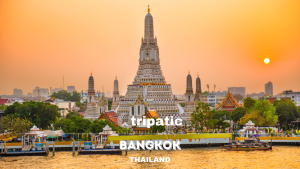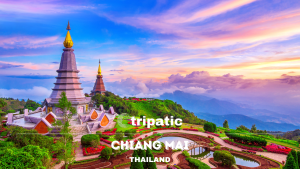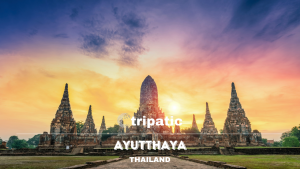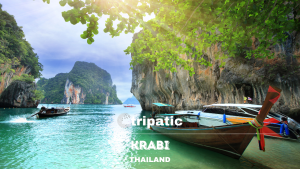Overview of Thailand
Picture Thailand for a second. Now, strip away the postcard-perfect beaches and bustling street markets. What’s left? An intricate tapestry of culture, history, and, frankly, some of the kindest folks you’ll ever meet.
Thailand, or the “Land of Smiles,” has a charm that goes beyond its tourist spots. It’s where ancient traditions fuse seamlessly with modern life. You’re as likely to stumble upon monks collecting alms at dawn as you are to encounter a tech startup on the corner. That’s the magic here—this weird, delightful mix of old and new.
Think of Bangkok. It’s a concrete jungle on steroids but packed with history and soul. The Grand Palace sparkles with gold, while a stone’s throw away, you’ve got markets selling everything from quirky trinkets to delicious street food. Ever tried mango sticky rice? Do yourself a favor. Visit a city like Bangkok and you’ll leave with your heart full and your pockets not too empty. It’s affordable, diverse, and just bustling with energy.
Venture north to Chiang Mai, and you’ll feel like you’ve stepped into another era. Temples, elephants, and the stunning mountains are a world away from Bangkok’s chaos. Small wonder digital nomads have made it their haven—it’s serene yet stimulating in its own quiet way.
Head south and you’ll hit the beaches. Phuket, Koh Samui, Krabi—it’s a litany of tropical paradises. Think beach bars, coral reefs, and sunset views that should come with a warning: may induce life envy.
So, why does everyone rave about Thailand? Because it’s everything: serene, chaotic, ancient, modern. It’s like life itself, capturing a spectrum of human experiences within its borders. You come for the sights and stay for the stories. Thailand’s got layers, and peeling them back is an adventure in itself.
History and Significance of Thailand
Thailand’s history is like a rich tapestry woven with threads of culture, tradition, and resilience. Imagine this: a land where ancient temples stand proudly amidst soaring skyscrapers, where tradition dances harmoniously with modernity. It’s a concoction of past and present that’s as enchanting as it is complex.
Let’s travel back in time to the 13th century when the Kingdom of Sukhothai was flourishing. This period, often referred to as Thailand’s ‘Golden Age,’ saw the birth of the Thai alphabet and the flowering of Thai art and culture. Picture intricate murals and delicate sculptures that whisper stories of a bygone era. Sukhothai wasn’t just a kingdom; it was the seed from which modern Thailand sprouted.
Fast forward to the Ayutthaya period, and you’ll find a kingdom that was a commercial and diplomatic powerhouse. Its capital, Ayutthaya, was a melting pot, attracting traders from Japan, China, India, and even Europe. Imagine bustling markets where languages intermingled and commerce thrived. But Ayutthaya wasn’t just about trade; its architectural splendor rivaled that of the greatest cities in the world at the time.
However, history isn’t just about the rise; it’s also about survival. The kingdom faced invasions, most notably from the Burmese in the 18th century, which saw devastating conflicts. It reminds me of a phoenix rising from the ashes, as Thailand didn’t just rebuild; it flourished anew. The foundation of the Chakri Dynasty in 1782 marked the beginning of modern Thailand, with Bangkok as its new capital. This period also heralded significant modernization under King Rama V, who cleverly balanced Western innovations with Thai traditions, ensuring the country’s sovereignty during a time when much of Southeast Asia was being colonized.
Speaking of modernization, the 20th century brought Thailand into the global limelight. The country deftly navigated the turbulent waters of two World Wars and the Cold War. It’s a bit like steering a ship through a storm, constantly adjusting the sails to catch the right winds. The astuteness of their leaders, coupled with the resilience of the Thai people, enabled them to maintain their independence and build a thriving nation.
Today, Thailand is a vibrant mosaic of ancient customs and contemporary innovation. The grand festivals, the reverence for the monarchy, and the omnipresent Buddhist influence reflect a nation deeply connected to its roots. Yet, the skyscrapers, bustling markets, and vibrant nightlife speak to a country that has embraced modernity without losing its essence. It’s like watching an old dance being performed to a new beat—hypnotic and invigorating at the same time.
In short, Thailand’s history is not a mere chronology of events but an epic saga of adaptability, wisdom, and cultural richness. It’s a place where every temple, every market, every festival is a chapter of a continuing story. So, whether you’re admiring the grandeur of the ancient ruins or marveling at the modern skyline, remember, you’re standing on a land that has seen it all and yet continues to shine brightly.
What to See and Do in Thailand
The Grand Palace, Bangkok
Imagine stepping into a jewel-studded kaleidoscope. The Grand Palace is just that. Not just a collection of buildings, but a testament to centuries-old architecture, culture, and history. Travelers often say it’s like walking into a dream where past and present dance together in a marvelous spectacle.
Wat Pho, Bangkok
Let’s be honest: seeing a reclining Buddha that big is both humbling and mind-blowing. Wat Pho isn’t just famous for its giant Buddha; it’s also a center for traditional Thai massage. So, while you’re there, why not treat yourself to an authentic experience you won’t forget?
Phi Phi Islands
If postcards could come alive, they’d look like Phi Phi Islands. The sheer emerald cliffs, crystal-clear waters, and vibrant marine life make it a perfect spot for snorkeling, diving, or just plain relaxing on the beach. Every photo you take here could be a screensaver.
Chiang Mai Night Bazaar
Picture this: bustling streets, vibrant stalls, the aroma of street food wafting through the air. The Chiang Mai Night Bazaar is not just a market; it’s a sensory overload in the best way possible. Whether you’re hunting for souvenirs or sampling local delicacies, this place is an adventure.
Ayutthaya Historical Park
Step back in time as you wander through the ruins of Ayutthaya. This UNESCO World Heritage site has temples, towers, and statues that whisper stories of a bygone era. It’s like a real-life history lesson, minus the homework.
Sukhothai Old City
As you stroll through the ancient ruins of Sukhothai, you can almost hear the echoes of old Siamese civilization. Known as the heart of early Thai culture, this historic wonderland offers an immersion into Thailand’s past like no other.
Doi Suthep, Chiang Mai
Feeling spiritual? Climb up to Doi Suthep. Not only do you get a breathtaking view of Chiang Mai, but the Wat Phra That temple itself is awe-inspiring. Each step you take feels like an ascent into tranquility and contemplation.
Floating Markets
Ever shopped from a boat? At places like Damnoen Saduak Floating Market, you can. This is more than a shopping trip; it’s a performance. Watch local vendors paddle their boats, brimming with fresh produce, souvenirs, and food, creating a vibrant, bustling scene on the water.
Phuket’s Patong Beach
Patong Beach is flashy and fabulous. By day, sunbathe or engage in water sports. By night, the place transforms into a pulsating party hub with neon lights, beach bars, and nightclubs. If you love the nightlife, Patong’s where it’s at.
Khao Yai National Park
For the nature-lover, Khao Yai is a paradise. With beautiful waterfalls, lush greenery, and diverse wildlife, it’s like entering a different world. Hike the trails, spot wild elephants, or just breathe in the serenity of nature undisturbed.
Cities to Visit in Thailand
 Ah, Bangkok. The heartbeat of Thailand. Imagine a place where skyscrapers rub shoulders with golden temples. The city is a sprawling metropolis, teeming with life. Tourists flock for its vibrant street food scenes, markets that never sleep, and opulent palaces. The Grand Palace with its intricate designs will leave you speechless. But don’t just stare at the structures; savor the flavors. From spicy pad Thai on the streets to the sophisticated ambiance of rooftop bars, Bangkok offers a taste of everything. You’ll revel in the chaos and find tranquility in unlikely places.
Ah, Bangkok. The heartbeat of Thailand. Imagine a place where skyscrapers rub shoulders with golden temples. The city is a sprawling metropolis, teeming with life. Tourists flock for its vibrant street food scenes, markets that never sleep, and opulent palaces. The Grand Palace with its intricate designs will leave you speechless. But don’t just stare at the structures; savor the flavors. From spicy pad Thai on the streets to the sophisticated ambiance of rooftop bars, Bangkok offers a taste of everything. You’ll revel in the chaos and find tranquility in unlikely places.
 Head north, and you’ll find Chiang Mai, Thailand’s cultural capital. Nestled in the mountains, it’s a juxtaposition of ancient and modern. The city is famous for its hundreds of temples – some nestled within the old city walls and others perched on mountains. There’s also a bustling night market where bargaining is an art. If you’ve got a penchant for adventure, the surrounding jungles offer everything from elephant sanctuaries to zip-lining. But it’s the city’s relaxed pace that really draws people in, making it a perfect retreat after the bustle of Bangkok.
Head north, and you’ll find Chiang Mai, Thailand’s cultural capital. Nestled in the mountains, it’s a juxtaposition of ancient and modern. The city is famous for its hundreds of temples – some nestled within the old city walls and others perched on mountains. There’s also a bustling night market where bargaining is an art. If you’ve got a penchant for adventure, the surrounding jungles offer everything from elephant sanctuaries to zip-lining. But it’s the city’s relaxed pace that really draws people in, making it a perfect retreat after the bustle of Bangkok.
 Picture this: white sandy beaches, azure waters, and vibrant nightlife. That’s Phuket in a nutshell. As Thailand’s largest island, it caters to a variety of tastes. Whether you’re a sun worshiper looking to lounge on Patong Beach, a diver eager to discover underwater treasures, or a party-goer in search of the next big club, Phuket has you covered. Beyond the beaches, there are lush mountains, tranquil waterfalls, and cultural experiences to be had. It’s a place that promises a little slice of paradise for everyone.
Picture this: white sandy beaches, azure waters, and vibrant nightlife. That’s Phuket in a nutshell. As Thailand’s largest island, it caters to a variety of tastes. Whether you’re a sun worshiper looking to lounge on Patong Beach, a diver eager to discover underwater treasures, or a party-goer in search of the next big club, Phuket has you covered. Beyond the beaches, there are lush mountains, tranquil waterfalls, and cultural experiences to be had. It’s a place that promises a little slice of paradise for everyone.
 Step back in time with Ayutthaya, the ancient capital turned UNESCO World Heritage site. About an hour’s drive from Bangkok, this city is a treasure trove of ruins and history. Picture walking amongst the remnants of grand palaces and towering temples. Each ruin tells a story, transporting you to a glorious past. The city spans out on an island flanked by rivers, offering a unique mode of exploration: boat tours. These water routes give you a different perspective of the historical splendor. If you’re a history buff or just love a good photo op, Ayutthaya is a dream.
Step back in time with Ayutthaya, the ancient capital turned UNESCO World Heritage site. About an hour’s drive from Bangkok, this city is a treasure trove of ruins and history. Picture walking amongst the remnants of grand palaces and towering temples. Each ruin tells a story, transporting you to a glorious past. The city spans out on an island flanked by rivers, offering a unique mode of exploration: boat tours. These water routes give you a different perspective of the historical splendor. If you’re a history buff or just love a good photo op, Ayutthaya is a dream.
 An underdog in the game but with a unique charm, Krabi is all about natural beauty. Towering limestone cliffs, crystal-clear waters, and hidden caves – it’s like straight out of a fantasy novel. Adventure seekers will find plenty to love: rock climbing, kayaking, and snorkeling among vivid coral reefs. The Railay Beach, accessible only by boat, feels like a secret hideaway. But it’s not all action – the serene environment is perfect for those who wish to kick back and relax. Each sunset here is a magical explosion of colors, offering a perfect end to your days.
An underdog in the game but with a unique charm, Krabi is all about natural beauty. Towering limestone cliffs, crystal-clear waters, and hidden caves – it’s like straight out of a fantasy novel. Adventure seekers will find plenty to love: rock climbing, kayaking, and snorkeling among vivid coral reefs. The Railay Beach, accessible only by boat, feels like a secret hideaway. But it’s not all action – the serene environment is perfect for those who wish to kick back and relax. Each sunset here is a magical explosion of colors, offering a perfect end to your days.
 Imagine a city where bustling beaches meet vibrant streets, and every corner offers something new to explore—that’s Pattaya. This coastal gem on Thailand’s eastern seaboard is famous for its lively atmosphere and endless entertainment options. From the golden sands of Pattaya Beach to the bustling markets and eclectic nightlife, Pattaya caters to every traveler’s desire. Whether you’re looking to unwind at a beachfront café, indulge in water sports, or experience the dazzling Alcazar Show, Pattaya has it all. Beyond the beaches, you’ll find lush gardens, cultural landmarks, and a thriving culinary scene, making it a dynamic destination that blends relaxation with adventure.
Imagine a city where bustling beaches meet vibrant streets, and every corner offers something new to explore—that’s Pattaya. This coastal gem on Thailand’s eastern seaboard is famous for its lively atmosphere and endless entertainment options. From the golden sands of Pattaya Beach to the bustling markets and eclectic nightlife, Pattaya caters to every traveler’s desire. Whether you’re looking to unwind at a beachfront café, indulge in water sports, or experience the dazzling Alcazar Show, Pattaya has it all. Beyond the beaches, you’ll find lush gardens, cultural landmarks, and a thriving culinary scene, making it a dynamic destination that blends relaxation with adventure.
Tips for Visitors
Dress Code
Anyone who’s been to Thailand can tell you, respect is paramount. Walk into a temple in your beachwear, and you’re bound to get the stink-eye. So, pack a pair of long pants and a shirt that covers your shoulders. It’s like showing you respect their history, and it’s worth it for the rich cultural experience you gain in return.
Local Etiquette
Thailand is often referred to as the “Land of Smiles” for a reason. Smiling isn’t just a pleasantry; it’s a way of life. When you’re haggling over prices at a market, which you absolutely should do, remember to keep it friendly. It’s more of a social ritual than a battle, like playing a game of charades where everyone knows the rules, and the stakes are just for fun.
Internet and Connectivity
One misconception is that you’ll be off the grid. Though it might take a bit of searching, you’ll find Wi-Fi in most cafes and hotels. But here’s a tip from a seasoned traveler: grab a local SIM card at the airport. It’s cheap and spares you the hunt for connection spots. And let’s face it, Google Maps can be your best friend in a bustling Thai market.
Language Basics
You don’t need to be fluent in Thai, but a few basic phrases can go a long way. Learning to say “hello” (sawatdee) and “thank you” (khop khun) will bring warm smiles and nods your way. It’s like finding the right key to open an unfamiliar door. Plus, it shows you’re making an effort, and that’s something locals truly appreciate.
Street Food
Thai street food is legendary. Imagine grabbing a steaming bowl of noodle soup, bursting with flavors, for less than the price of a soda back home. But if you’re eyeing that mouth-watering dish, don’t be shy—watch where locals are lining up. Their choice is almost always a signal of top-notch taste. Think of it as culinary crowd-sourcing.
Getting Around
Navigating Thailand can be an adventure, but that’s part of the charm. Tuk-tuks, those three-wheeled taxis, are iconic and certainly worth a ride. Just be prepared to negotiate your fare—they don’t come with meters. On the other hand, using the BTS Skytrain in Bangkok is surprisingly smooth and efficient, whisking you above the chaotic streets below.
Cultural Sensitivity
Temples and royal places have rules, and it’s crucial to follow them. Don’t point your feet at Buddha statues, and don’t touch the head of a Thai person, even a child. It’s seen as disrespectful. Think of it like stepping into someone else’s home and keeping off the white carpet.
Health and Safety
Thailand is generally safe, but it’s good to stay savvy. Drink bottled water and watch out for ice in street drinks. And don’t forget that Thailand’s sun can be deceptively intense—you’ll thank yourself for carrying sunscreen and a hat.
Thailand is a tapestry of vibrant culture, mouth-watering cuisine, and warm-hearted people. Follow these tips, and you’re set to weave your own rich and colorful memories.
Local Customs and Etiquette
Traveling to Thailand can feel like stepping into another world, one filled with exotic traditions and cultural nuances that might seem a bit puzzling at first. But with a little understanding, you can navigate these customs like a seasoned local.
Respect for the Monarchy
First and foremost, the Thai people hold their royal family in extraordinarily high regard. There are portraits of the king and queen everywhere, from bustling marketplaces to serene temples. It’s important to be respectful and avoid any negative comments about the monarchy. Think of it like speaking ill of family at a reunion—not a good move.
Wai Greeting
Then there’s the wai, a traditional Thai greeting that’s part bow, part prayer. The proper way to do the wai is to press your palms together in a prayer-like fashion and bow your head slightly. It’s like a handshake, but with an extra touch of grace. Remember, the higher the hands, the more respect shown. Save the deepest wais for monks and elders to show reverence.
Shoes Off, Please
When entering someone’s home or certain places like temples, it’s customary to remove your shoes. Think of it as leaving the outside world at the door. It’s not just about keeping the floors clean—it’s a sign of respect. It always helps to have a clean pair of socks ready, though you might find the cool tiles a rather nice surprise on a hot day!
Feet and Head Etiquette
If you’ve ever been on a bus and someone props their feet up near your head, you know it feels pretty disrespectful. In Thailand, this is even truer. Feet are considered the lowest and dirtiest part of the body. Don’t point your feet at people or religious objects. On the flip side, the head is the most sacred. Avoid touching a person’s head, even playfully. It’s just not done.
Dining Manners
Ah, Thai food. It’s a wonderful experience, but there are etiquette rules to follow here too. When dining, wait until the eldest person starts eating before you dig in. It’s a way of showing respect to experience and age. Oh, and don’t be surprised if you see food being shared family-style. Individual plates are less common—think of it as a community potluck.
Temple Visits
Visiting a temple? Cover up! Modesty is key. Wearing shorts or sleeveless tops can be seen as disrespectful. Imagine you’re dressing for a very important meeting—because in a way, you are. Temples also often have stricter rules like no photography or loud conversations, so keep an eye out for signs and cues.
These customs, while they might seem small, go a long way in showing respect and kindness to your hosts. And who knows? You might even find them charming, quirks you come to love about this fascinating country.
Safety and Regulation
Traveling to Thailand is often an exhilarating experience, but keeping safety in mind is paramount. First off, let’s chat about health. Thailand is a tropical paradise, but that means it comes with its own set of health concerns. Think about the mosquito-borne diseases like dengue fever. No one wants to spend their vacation scratching like a madman, so packing some insect repellent is a no-brainer.
Now, the roads – they are a whole different ball game. I’ve driven through Bangkok, and let me tell you, it’s like participating in a chaotic ballet. The city’s roads can be a bit, how shall I put it, overwhelming. Traffic signals can feel more like suggestions than actual rules. If you’re renting a scooter, which is a fantastic way to explore the islands, always wear a helmet. Trust me, your mother will sleep better at night.
Then there’s the matter of scams. They can range from overpriced tuk-tuk rides to elaborate schemes involving fake jewelry stores. I remember my first time in Bangkok, and a seemingly well-dressed gentleman promised me a fantastic deal on gemstones. Spoiler alert: it was a scam. It’s always good to check reviews online and ask fellow travelers about their experiences.
Pickpocketing is another issue in heavily crowded places, especially in markets and popular tourist attractions. Keep your valuables close, rather than making them an easy target. A simple money belt can work wonders.
As for the nightlife, Thailand is known for its vibrant scene that stretches well into the wee hours. But party smart. Stick to well-known clubs and avoid accepting drinks from strangers. Sounds cliché, but it’s sage advice – remember, not all that glitters is gold.
Lastly, let’s talk legal stuff. While Thailand is famous for its exotic delicacies and fabulous beaches, it also has stringent laws. Thailand doesn’t mess around with its drug policies. Getting caught with narcotics can lead to serious consequences. Also, being respectful towards the royal family isn’t just courteous – it’s legally mandatory. Even a casual comment can land you in hot water.
Understanding these tidbits won’t just make your experience stress-free but also enrich your journey.
Best Time to Visit Thailand
Ah, Thailand! The name alone conjures images of pristine beaches, bustling markets, and awe-inspiring temples. But let’s get down to brass tacks: when is the best time to explore this Southeast Asian gem? Well, it’s a bit like cooking the perfect Pad Thai—timing is everything.
Cool Season (November to February): If you’re looking to wear your favorite summer clothes and enjoy cool breezes, then this is your golden window. Imagine stepping off the plane and feeling only a gentle whisper of humidity. Mornings in Bangkok can even be a bit chilly. Think of it like catching a generous sale when everything aligns just right.
Hot Season (March to June): Now, this is for the brave-hearted. It’s like stepping into a sauna. If you don’t mind feeling like a roasted peanut, you’ll find fewer crowds and more elbow room at popular attractions. And trust me, a mango sticky rice tastes even sweeter when you’ve worked up a sweat exploring ancient ruins.
Rainy Season (July to October): Ah, the monsoon rains. They are a double-edged sword. On one hand, you’ve got lush landscapes that look straight out of a travel magazine. On the other, there’s the risk of sudden downpours. Picture this: you’re having the time of your life on a tuk-tuk ride when, out of nowhere, the sky opens up like a burst water balloon. As long as you carry a light rain jacket and a sense of adventure, you’ll be golden.
So when is the perfect time? It’s a bit like asking when is the best time to see a Michelin-star chef in action. It all depends on your tolerances and what type of experience you crave. If you’re still on the fence, consider this: Thailand’s festivals and local events can be true game-changers. Loy Krathong in November, or the exuberant Songkran in April, just might tip the scales for you.
Think about it this way: no matter when you go, Thailand has an ace up its sleeve ready to dazzle you. Pack accordingly, anticipate a few surprises, and let the land of smiles work its magic on you.
Common FAQ about Traveling in Thailand
What’s the best time to visit Thailand?
You’ll want to visit Thailand when the weather’s just right—it’s like finding the sweet spot in a perfect curry recipe. Typically, the cool season from November to February is ideal. But if you’re okay with a bit of rain, the country is lush and less crowded during the monsoon season from June to October.
Do I need a visa?
Depends on where you’re from and how long you want to stay. Most nationalities can enter visa-free for 30 days if arriving by air, or 15 days if arriving by land. Planning a longer stay? A tourist visa will let you linger a bit more—just make sure you check the latest requirements before you go.
How vital is learning Thai?
Not essential, but it’s like having an extra scoop of coconut ice cream after a spicy meal—totally worth it. Many Thais, especially in tourist areas, speak enough English to help you get by. But a few Thai phrases can earn you smiles and maybe even better prices. Try “Sawadee” for hello and “Khob khun” for thank you.
What’s the best way to get around?
Getting around Thailand is like selecting dishes at a food market—so many options! Tuk-tuks are fun for short trips, while motorbike taxis are quick and thrilling. For longer distances, buses or trains offer scenic rides at a relaxed pace. And let’s not forget the low-cost airlines—perfect if you’re hopping from Bangkok to Chiang Mai or Phuket.
Is Thailand safe for solo travelers, especially women?
Yes, but as with anywhere, stay vigilant. Think of it as walking a busy market alley—generally safe but keep an eye on your belongings. Most solo travelers, including women, find Thailand welcoming and comfortable. Use common sense, avoid sketchy areas at night, and trust your instincts. Always carry a copy of your ID, and if in doubt, ask locals or your hotel for advice.
How’s the food for vegetarians or vegans?
Travelling as a vegetarian in Thailand is like diving into a treasure trove of flavors. Many dishes can easily be tweaked to suit vegetarian or vegan diets. Look for “jay” (เจ), which means vegetarian. And don’t hesitate to communicate your preferences—Thais are generally happy to accommodate.
What should I wear?
Think practical and respectful. In the temples and religious sites, covering your shoulders and knees is key. But on the beach? Light, casual wear is the way to go. However, Thai people appreciate when travelers dress modestly in non-beach settings. A pair of sandals with good grip can be your best friend when exploring different terrains.
How can I avoid scams?
Like a seasoned traveler picking the freshest fruits, be discerning. Avoid offers that seem too good to be true. Use reputable services for taxis and tours, and ask for recommendations from fellow travelers or your accommodation. A friendly chat with locals can also provide valuable insights.
Can I drink the tap water?
Stick to bottled or filtered water. Think of it like choosing a safe and clean option rather than taking a risk. Bottled water is widely available and inexpensive. Most restaurants and hotels also provide safe drinking water.
Any tips for dealing with the local currency?
The Thai Baht (THB) is your gateway to experiencing Thailand. ATMs are everywhere, but check the fees your bank charges for international withdrawals. Using cash is common, especially in markets and small eateries. However, credit cards are accepted in most hotels and larger establishments.
How’s the internet and connectivity?
Surprisingly reliable! While exploring, you’ll often find Wi-Fi at cafes, hotels, and restaurants. For on-the-go internet, grab a local SIM card. They’re cheap and easy to find at the airport or convenience stores. It’s like having a guide in your pocket—staying connected enhances your travel experience.










